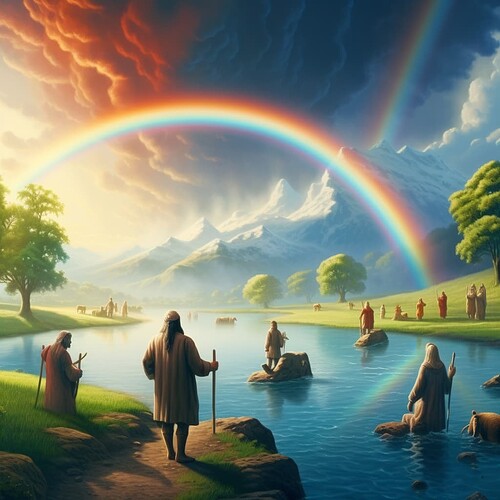Join us as we journey through Genesis 9 and 10, pivotal chapters in the story of humanity’s rebirth and diversification after the Great Flood. These chapters mark significant moments of divine promise and the early stages of human expansion across the earth.
 Genesis 9 - God’s Covenant with Noah:
Genesis 9 - God’s Covenant with Noah:
-
Genesis 9 presents the establishment of God’s covenant with Noah and all living creatures, symbolized by the rainbow. This covenant represents a promise of mercy and a new beginning for mankind and the earth.
-
This chapter also narrates Noah’s planting of a vineyard, his subsequent drunkenness, and the actions of his son Ham, leading to the curse of Canaan. This incident raises complex questions about human behavior and family dynamics.
-
Key Verse:
‘I establish my covenant with you: Never again will all life be destroyed by the waters of a flood.’ - Genesis 9:11
- This verse is a cornerstone of God’s commitment to humanity, assuring that the earth will not be destroyed by flood again, instilling hope and a sense of security in the continuity of life.
 Genesis 10 - The Table of Nations:
Genesis 10 - The Table of Nations:
- Known as the Table of Nations, Genesis 10 outlines the genealogical spread of humanity post-Flood through Noah’s descendants. This chapter is foundational for understanding the origins of various nations and peoples in the biblical narrative.
- Key Verse:
‘These are the clans of Noah’s sons, according to their lines of descent, within their nations. From these the nations spread out over the earth after the flood.’ - Genesis 10:32
- This verse emphasizes the diversification and spread of humanity, illustrating the fulfillment of God’s plan to repopulate and steward the earth.
 Reflective Q&A:
Reflective Q&A:
 The Significance of the Covenant:
The Significance of the Covenant:
- Question: What does the covenant in Genesis 9 represent for humanity?
- Answer: It signifies God’s enduring mercy and commitment to the preservation of life on earth, offering assurance of His faithfulness and care.
 Understanding the Table of Nations:
Understanding the Table of Nations:
- Question: How does the ‘Table of Nations’ in Genesis 10 set the stage for future biblical events?
- Answer: It provides a framework for the emergence of different peoples and cultures, setting the context for the unfolding of God’s plan through diverse lineages and nations.
 Reflective Thoughts:
Reflective Thoughts:
- Reflect on the meaning and implications of God’s promises in your life, especially the aspects of mercy and preservation highlighted in Genesis 9.
- Consider the significance of the interconnectedness and diversity of humanity as portrayed in Genesis 10. How does this shape your understanding of our shared heritage and God’s overarching plan?
 Let’s Discuss:
Let’s Discuss:
- We invite you to share your thoughts on Genesis 9 and 10. How do these chapters speak to you about God’s faithfulness, the unity of mankind, and the unfolding of human history?
 See You Tomorrow:
See You Tomorrow:
- Continue your exploration of Genesis with us tomorrow. For the full January reading plan, visit here.
Join us on this insightful journey through Genesis. Dive deeper each day, and let’s grow in our understanding of God’s covenant and the early history of humankind.
 Stay Connected:
Stay Connected:
- Keep up with our daily readings and insights by subscribing to the AIgniteScripture Newsletter. Subscribe here.
genesis #Covenant #RainbowPromise #NoahsArk #BiblicalGenealogy #UnityOfMankind #AIgniteScripture
